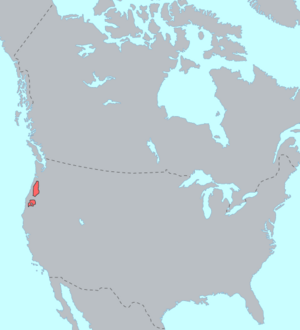Takelma language facts for kids
Quick facts for kids Takelma |
||||
|---|---|---|---|---|
| Taakelmàʔn | ||||
| Native to | United States | |||
| Region | Oregon, Rogue Valley along the middle course of the Rogue River | |||
| Ethnicity | Takelma, Latgawa, Cow Creek band of Upper Umpqua | |||
| Extinct | 1934, with the death of Frances Johnson | |||
| Language family |
Penutian?
|
|||

Takelma (south), with the Kalapuyan languages to the north
|
||||
|
||||
Takelma was a language spoken by several Native American groups in Oregon. These groups included the Latgawa people, the Takelma people, and the Cow Creek band of Upper Umpqua.
A famous language expert named Edward Sapir was the first to study Takelma in great detail. He wrote about it in his university paper, The Takelma Language of Southwestern Oregon. The last person who spoke Takelma fluently was Frances Johnson (Gwísgwashãn). She worked with Sapir to help him learn about the language. Sadly, Takelma became extinct in 1934 when Frances Johnson passed away. Today, people are working to create a dictionary from English to Takelma. They hope this will help bring the language back to life.
Contents
What Are Takelma Dialects?
Just like different regions might have different accents or words, languages can have dialects. These are slightly different versions of the same language. Takelma had a few dialects:
- The Latgawa dialect was spoken in southwestern Oregon. It was used along the upper Rogue River.
- The Lowland (or Takelma) dialect was also spoken in southwestern Oregon. This one was used in the Rogue Valley.
- There might have been a Cow Creek dialect too. This would have been spoken along the South Umpqua River, Myrtle Creek, and Cow Creek.
How Is Takelma Related to Other Languages?
Languages often belong to larger families, like how your family has different members. Takelma is often thought to be part of a big language family called Penutian. This idea was first suggested by Edward Sapir.
Within the Penutian family, some experts used to group Takelma with the Kalapuyan languages. They called this group "Takelma–Kalapuyan." However, newer studies suggest that Takelma and Kalapuyan are actually very different. Their morphological structures (how words are built from smaller parts) are not alike. Because of this, many experts now believe they are not closely related.
How Takelma Words Are Built
Takelma is a polysynthetic language. This is a fancy way of saying that you can link many small word parts together. These parts are called morphemes. By adding these parts, especially to verbs, one single Takelma word can hold a lot of meaning. It can even mean as much as a whole sentence in English!
Understanding Takelma Tenses
Takelma had six different tenses. Tenses tell you when something happens.
- Aorist: This was the basic tense. It could mean something happening in the immediate future, now, or in the past.
- Potential: This tense showed something that could happen.
- Future: This was for things that will happen.
- Inferential: This tense was used when you were guessing or inferring something.
- Present Imperative: This was for giving commands right now.
- Future Imperative: This was for giving commands about something to do later.
Showing Ownership in Takelma
In Takelma, you showed who owned something by adding small parts to words. These parts are called affixes. Most of them were added to the end of a word (suffixes), but one was added to the beginning (prefix).
Here are some examples of how ownership worked:
- When talking about family members, Takelma used a special set of affixes.
- Wi-wá: meant 'my younger brother'.
- wà:-ʔtʰ meant 'your younger brother'.
- wi:-xa meant 'his younger brother'.
- For regular words, like 'song' or 'head', different affixes were used.
- hè:l-tʰekʰ meant 'my song'.
- hè:l-tʰa meant 'his song'.
- tàkax-tekʰ meant 'my head'.
- tàkax-ta meant 'his head'.
- Takelma also had a way to show where something was.
- ha-wili-té meant 'in my house'.
- But wili-tʰkʰ just meant 'my house'.
- xa:-kʷel-té meant 'between my legs'.
- While kʷé:lx-tekʰ meant 'my legs'.
How Takelma Showed Objects
Takelma had a special system for showing who or what was the object of a verb. The object is the person or thing that the action is done to. For example, in "I see you", "you" is the object.
- For "me" or "us" (first person objects), and "you" (second person objects), Takelma used clear endings on the verb.
- For "him," "her," "it," or "them" (third person objects), it was a bit more complex. Sometimes there was no ending, and sometimes a special ending -kʰwa was used.
The -kʰwa ending was used in specific situations:
- When the person doing the action (the subject) was also a third person.
- When the object was "higher" in importance or "aliveness" than the subject. For example, if the object was a human or a mythical animal treated like a human.
- When the subject and object were equally "alive," but the object was more important to the story.
Common Takelma Words
Here are some basic numbers in Takelma:
| Takelma | English |
|---|---|
| [mìːʔskaʔ] | one |
| [kàːʔm] | two |
| [xìpiní] | three |
| [kamkàm] | four |
| [déːhal] | five |
| [haʔiːmìʔs] | six |
| [haʔiːkàːʔm] | seven |
| [haʔiːxín] | eight |
| [haʔiːkó] | nine |
| [ìxtiːl] | ten |
Images for kids
See also
 In Spanish: Idioma takelma para niños
In Spanish: Idioma takelma para niños


